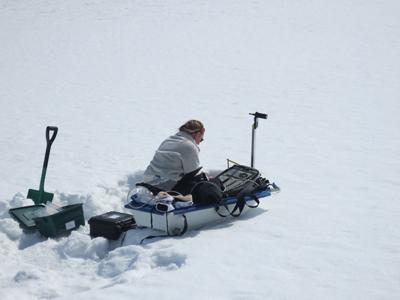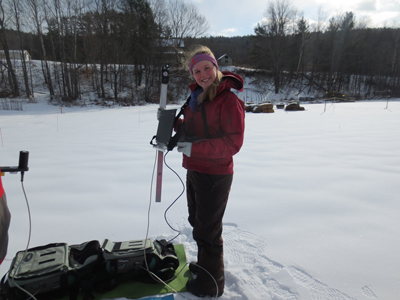The Intensive Snow Measurements data portal provides a suite of snowpack characteristics: snow depth and density, grain size, albedo, temperature, and major ion and black carbon chemistry data, collected from three sites in New Hampshire during the winters of 2013 through 2016. These near daily measurements help us better understand the temporal evolution of snow throughout the winter season and provide insights into the role of New Hampshire's seasonal snowpack in the surrounding ecosystem.

Snow characterization measurements were made over the winter season at three principally non-forested sites across New Hampshire, with funding from the NH EPSCoR project. These measurements were made in order to investigate and better understand the dynamics of snowpack impurities throughout the winter as well as address the effects that black carbon (BC or soot) and snow grain size have on the surface energy budget in New Hampshire.
Snow plays an important role in mid-latitude temperate environments through its impact on surface energy balance and storage of water and chemical impurities that are released upon melt. The snowpack stores atmospheric aerosols and trace gases throughout the winter season, typically releasing the majority of the soluble species into the surrounding ecosystems very quickly early in the melt. This seasonal event is called the ionic pulse. Depending on the amount of impurities in the snowpack and the timing of the melt, an ionic pulse can have immediate negative effects in the accompanying watershed.
Some particulate impurities found in snow (e.g. black carbon) are typically distinct from soluble snowpack species in that they do not dissolve in water. Specifically, the insoluble nature of BC particles leads to less efficient removal from the snowpack during melt, which, in turn, may lead to an increase in BC concentration on the snowpack surface during melt.
The effective radiative forcing of BC is much higher than that of carbon dioxide, and even a small amount of BC on the surface of the snowpack has a well-documented effect on albedo. Consequently, BC has the potential to have a large impact on the surface energy budget in New Hampshire during the snow cover season.

Winter in the northeastern United States has changed over the last several decades, resulting in shallower snow packs, fewer days of snow cover, and increasing precipitation falling as rain in the winter. As these climatic changes occur, it is imperative that we understand current controls on the evolution of seasonal snowpacks in the region.